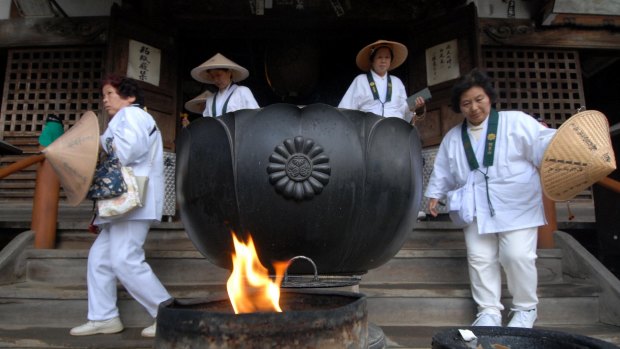This was published 6 years ago
Japan's Shikoku Island pilgrimage: The Japanese equivalent of Spain's Camino de Santiago
By Daniel Scott

Pilgrims' progress: 'Henro' leave Okuboji Temple - the last of 88 stops on the Shikoku Island pilgrimage.Credit: KATSUMI KASAHARA
This being Japan, there are many ways of completing the Shikoku Island pilgrimage route, the nation's equivalent of Spain's Camino de Santiago.
If you have a spare 1 million yen (about $11,500), you can travel to all but 21 of the 88 temples along the route by helicopter, hovering above each long enough to pray and chant.
The tour, which takes four days and three nights, brings pilgrims by bus to temples too dangerous to visit in a chopper.
If, for some reason, you are physically incapacitated or too busy to leave the office, you can hire a proxy to do the pilgrimage for you. Your replacement travels by car and collects all the temple stamps required for your spiritual enrichment.
Or, in a development that may signal the future of tourism, you can do the whole pilgrimage on a virtual tour. The "Ohenro-san" game, for Nintendo consoles, costs about 12,800 yen ($147) and allows you to walk on a treadmill to each of the 88 temples, images of which appear on screen.
But, for this would-be Australian henro (pilgrim) there is only one way to go in the early winter drizzle, a heated mini-bus in which to beetle between three temples.
I begin, appropriately enough, by visiting temple No.1, Ryozenji, the first stop on what for real pilgrims would be an 1100-kilometre trek lasting two months. The truly earnest add 20 secondary "bangai" temples, increasing the total to 108 and the distance to 1400 kilometres.
Usually followed in a clockwise direction, the route forms a circle around the circumference of the island of Shikoku, off the southern coast of Japan's main Honshu island, in the Seto Inland Sea.
The aim of the pilgrimage can be to remember dead family members or friends or simply to meditate on your life's progress as you walk the route, much of which is through the countryside or along the coast.
It can also be an exercise in wandering aimlessly, as author Oliver Statler states in his book, Japanese Pilgrimage: "This pilgrimage has no goal in the usual sense, no holy of holies to which one journeys … This pilgrimage is essentially a circle: a circle has no beginning and no end. And so it is not at all important where one begins. What is important is that one go all the way around and return to one's starting point. One must close the circle."
Although I'm only dipping a toe into the pilgrimage, there is something cleansing about standing in the rain, in the grounds of the first temple, as groups of older Japanese arrive to begin their spiritual journey.
Some are dressed in the entire henro garb, with conical sedge hat keeping off the rain and a white vest (hakui) to represent purity. They hold a rosary, a pilgrimage book in which to collect commemorative stamps from every temple, and a wooden staff, said to embody Kobo Daishi or Kukai, the inspiration for the trek.
Kukai was a Buddhist monk, born in 774AD on Shikoku Island, who founded Shingon Buddhism in Japan following a visit to China. A priest, poet, adviser to the emperor, educator and master calligrapher, he is revered throughout Japan.
The Shikoku pilgrimage links places that Kukai visited in the ninth century and was first completed about 300 years later. It now attracts tens of thousands of pilgrims annually.
I begin my journey, as all henro do, by banging a large bell at Ryozenji and visiting its shrine, where about 50 people are chanting a sutra over and over again. Then I light an incense stick and deposit wishes scrawled onto paper strips into a "nameslip" box in the main hall.
All of the temples I visit today are distinguished by their simplicity, with unelaborate surrounds and none of the ornate detail of Kyoto's religious buildings.
Nothing at Ryozenji or the nearby second temple, Gokurokuji, distracts from the prayer and meditation that are the purpose of the pilgrimage. There is a stillness and intensity at each that is moving to behold.
I find myself contemplating my lost parents and siblings at each temple.
Of course, pilgrims still have to eat. So I make time for a delicious tempura and sashimi lunch at a local restaurant, where the simplicity disguises the most elegant and complex of flavours and textures.
But there's no rest for the wicked and while I don't have a helicopter, after lunch I find myself, thanks to going around in circles, at temple 88, the final destination on the Shikoku pilgrimage route.
Located on the slopes of Mount Nyotai, Okuboji Temple is said to have been built by the priest Gyoki in 716AD and to include a sanctuary and a principal deity created by Kukai.
Set against the granite mountain, veiled in misty drizzle and suffused with the aroma of incense, Okuboji is as atmospheric a place to complete a spiritual journey, with no end, as I can imagine.
TRIP NOTES
MORE INFORMATION
Jnto.org.au
tourismshikoku.org/henro
FLY
Japan Airlines flies to Takamatsu airport, in Shikoku Island's Kagawa prefecture, from Tokyo's Haneda airport; journey time is 75 minutes. See au.jal.com.
TOUR
Walkjapan.com offers a guided 11-day, 10-night tour of the most scenic parts of the Shikoku pilgrimage route from JPY484,000 ($5570).
Daniel Scott was a guest of the Japan National Tourist Organisation.
Sign up for the Traveller Deals newsletter
Get exclusive travel deals delivered straight to your inbox. Sign up now.